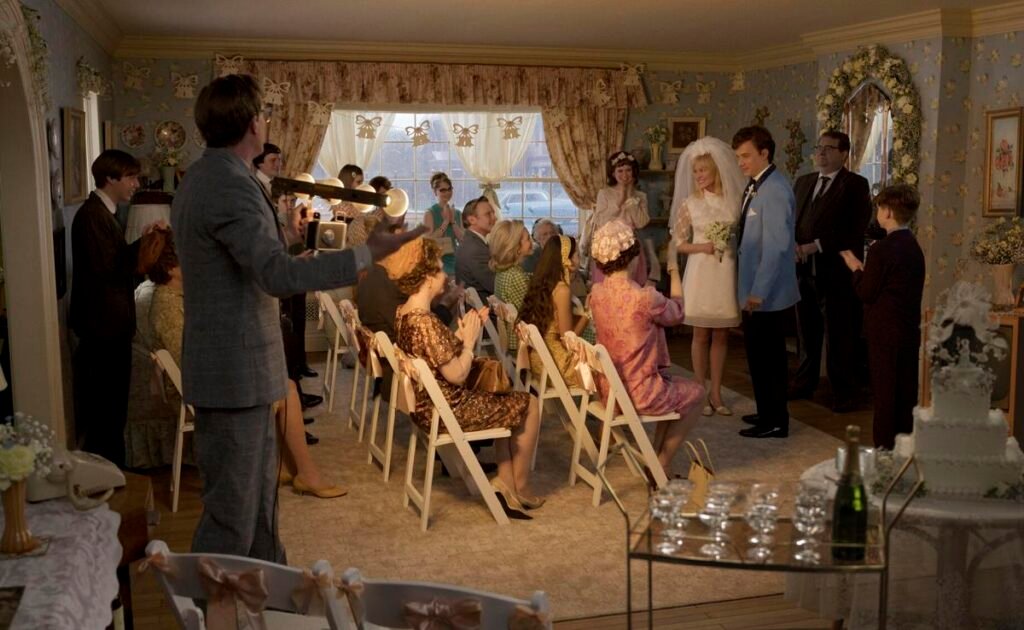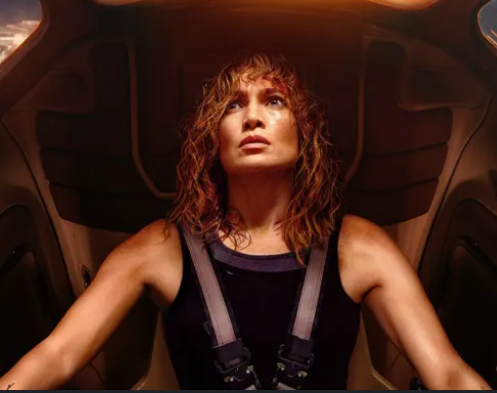Tom Hanks and Robin Wright reunite under Robert Zemeckis’s direction, yet bold experimental choices overshadow what could have been a compelling story.

Star Cast: Tom Hanks, Robin Wright, Paul Bettany, and Kelly Reilly
Director: Robert Zemeckis
What’s Good: The concept is intriguing, and seeing Zemeckis and his cast strive to bring it to life is engaging, but the film repeatedly falters, losing its footing soon after it begins.
What’s Bad: Execution is crucial, but Zemeckis struggles to bring his screenplay to life. Overuse of CGI leaves scenes looking artificial and overdone, diminishing the film’s potential impact.
Loo Break: Midway through, the movie quickly loses its narrative focus, making it hard to stay engaged as the plot unravels and momentum fades.
Watch or Not? Skip this one—other works, especially the original graphic novel, handle this concept with far greater skill and impact, making this adaptation feel lackluster by comparison.
Language: English (with subtitles).
Available On: Theaters
Runtime: 104 minutes.
Movie Review: Robert Zemeckis’s Here – A Bold Concept That Fails to Connect
Introduction
Robert Zemeckis, one of the most iconic American filmmakers, is known for pushing the boundaries of storytelling and technology. With classics like Back to the Future, Forrest Gump, and Castaway, he’s shown a remarkable ability to captivate audiences and deliver unforgettable stories. His more recent films, however, have seen mixed results, with some of his projects struggling to resonate. In Here, Zemeckis reunites with actors Tom Hanks and Robin Wright to tackle an ambitious concept, adapting the unique graphic novel by Richard McGuire. The result is visually intriguing but ultimately flawed, as the film’s experimental choices overshadow its storytelling.
A Daring Concept with Mixed Execution
The concept behind Here is fascinating. The story centers on a single location in North America, exploring how it changes over time—from the primordial Earth to the 21st century. It’s an ambitious idea and one that feels suited to Zemeckis’s vision, especially with the chance to explore history’s evolution and showcase technological advances through cinema. The challenge lies in translating this concept effectively on screen, especially given that the original graphic novel allowed readers to control their pace, taking in each panel as quickly or slowly as they wished.
This control is lost in the film format, where audiences are taken through a relentless series of time jumps and transitions, making it difficult to connect with the characters or grasp the story’s deeper layers. Though initially engaging, this approach soon becomes repetitive, with the rapid switches between periods leaving little room for emotional investment or cohesive storytelling.
The Burden of Experimental Filmmaking
Zemeckis is known for experimenting with technology, but his recent work, unlike that of James Cameron, has struggled to balance technical innovation with engaging storytelling. While Cameron’s films, such as Avatar, have used groundbreaking techniques to enhance their emotional impact, Zemeckis’s approach often feels more like a showcase of effects than a narrative enhancement. In Here, he utilizes CGI extensively to create seamless transitions between time periods, but the over-reliance on CGI renders scenes artificial, creating a sense of detachment that undermines the film’s emotional impact. The execution falters as visual effects take precedence over meaningful story progression.
A Cast Worth Watching, Even When the Script Fails
Tom Hanks and Robin Wright lead the cast with performances that are commendable given the limitations of the script. Hanks and Wright have proven chemistry, and their moments on screen offer brief glimpses of connection amid the otherwise disjointed narrative. They carry their roles with a depth and sincerity that the story doesn’t always deserve. Their performances are grounded, capturing subtle emotions that add warmth to an otherwise cold narrative structure. Despite the film’s flaws, watching Hanks and Wright work together is still one of the movie’s highlights.
Paul Bettany and Kelly Reilly also contribute strong performances, but their roles are overshadowed by the prominence given to Hanks and Wright. Bettany and Reilly’s characters struggle to stand out in a story that prioritizes its experimental format over character development, making it difficult for their talents to shine. It’s a shame, as they are both excellent actors who could have brought more to their roles if the script had given them more to work with.
The Drawbacks of an Overly Structured Narrative
One of the film’s biggest issues is its rigid structure. The narrative jumps between time periods, with each scene confined to the same room in a house, as events unfold from different eras. This setting works well in the graphic novel, where each panel captures a unique moment in time, allowing readers to explore at their own pace. However, in the film, this approach feels limiting, with the unchanging backdrop of a single room ultimately reducing the story’s impact.
The limited setting also constrains the actors, who are tasked with bringing a variety of historical moments to life within the same four walls. While they work hard to keep their performances believable, the staging feels better suited for a play than a film. This rigid framework creates a barrier to immersion, as audiences are constantly reminded that they’re watching scenes unfold in the same small space. The choice to anchor the story in a single location is conceptually interesting but fails to engage as the novelty fades.

An Experimental Approach That Lacks Depth
While Zemeckis’s ambition is clear, the execution leaves much to be desired. By focusing so heavily on the film’s technical aspects, he loses sight of the story’s emotional core. In the early scenes, the transitions between different time periods are intriguing, but the novelty wears thin as the movie progresses, revealing a lack of substantive development in the characters and plot. The story becomes increasingly difficult to follow, as scenes jump back and forth without a clear sense of progression or purpose.
The film’s pacing suffers as a result, with the repetitive transitions between eras feeling like empty spectacle rather than meaningful storytelling. At just around 90 minutes without credits, Here feels much longer than its runtime, as the audience is taken through a series of loosely connected vignettes that fail to cohere into a compelling narrative.
A Legacy of Innovation, But Recent Struggles Persist
Robert Zemeckis’s career has been marked by groundbreaking films that push the boundaries of technology and storytelling. However, his recent projects have leaned too heavily on technical gimmicks, sacrificing depth for spectacle. While his classics remain beloved, his newer work has been more hit-or-miss, often falling short of the emotional resonance and engagement that made his earlier films so memorable. In Here, Zemeckis seems more focused on executing an ambitious concept than on delivering a satisfying story.
The decision to rely so heavily on CGI detracts from the authenticity of the film, creating a sense of detachment that leaves viewers struggling to invest in the characters or their stories. Zemeckis’s direction lacks the fluidity and creativity needed to bring the graphic novel’s unique structure to life on screen. Rather than adapting the concept in a way that plays to the strengths of cinema, he clings too closely to the source material’s structure, resulting in a film that feels like a missed opportunity.
Final Verdict: An Experiment That Misses the Mark
Here offers an intriguing premise and a strong cast, but it ultimately falls short due to an overreliance on technical experimentation at the expense of narrative depth. The film’s CGI-heavy visuals create an artificial feel that clashes with the story’s attempt at emotional resonance, while the repetitive time jumps make it difficult to stay engaged. Despite the best efforts of Tom Hanks, Robin Wright, and the supporting cast, Here fails to justify its ambitious concept, leaving audiences with a film that is more frustrating than fulfilling.
For fans of Zemeckis’s earlier work, Here may be a disappointment, as it highlights his recent tendency to prioritize innovation over storytelling. Though he has proven capable of crafting unforgettable films, his latest project lacks the charm and emotional weight of his classics. Ultimately, Here feels like a film that’s more suited to the stage or the pages of a graphic novel, as its cinematic adaptation fails to capture the immersive potential of the story.
If you’re curious about the concept, it may be worth checking out the original graphic novel by Richard McGuire, which allows readers to explore the story’s structure at their own pace. But for those hoping for a compelling cinematic experience, Here is unlikely to deliver, as its experimental approach overshadows what could have been a powerful narrative.
Stay tuned to Club4Celebs for more updates.


